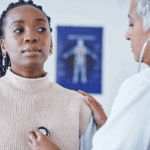September is Ovarian Cancer Awareness Month. You may have been diagnosed with ovarian cancer or know another woman who has been diagnosed with this type of cancer. According to the American Cancer Society, about 1 in 87 women will develop ovarian cancer in their lifetime, and 1 in 130 women will die from the disease. In 2024, almost 20,000 new cases of ovarian cancer will be diagnosed in women and roughly 13,000 women will die from this cancer type.1
If you’re a Black woman living in the United States, you are more likely to have a metastatic disease at the time you are diagnosed with ovarian cancer. This is an advanced form of the disease where the cancer has spread from the ovaries or fallopian tubes to other parts of the body. Black people are more likely to have advanced disease, less likely to receive specific treatments, and more likely to have worse outcomes as a result of ovarian cancer.2,3,4
What is Ovarian Cancer?
Cancer is a disease that occurs when abnormal cells grow out of control in the body. Ovarian cancer (OC) is cancer that develops in a woman’s ovaries or fallopian tubes. The ovaries are a pair of reproductive glands on each side of the uterus that make eggs and female hormones. The eggs move from the ovaries through the fallopian tubes into the uterus, where they stay and develop into a fetus if fertilized.5,6
How Ovarian Cancer Affects Black Women
Ovarian cancer is the fifth-leading cause of cancer death among women in the U.S.7,8 There has been progress in how ovarian cancer is treated, but these advancements have not benefited all racial and ethnic groups in the same way.7,8 Black women specifically are not experiencing the same benefits from newer ovarian cancer treatments as white women.9
Although fewer Black women develop ovarian cancer than white women, more Black women die from ovarian cancer than white women.9
Based on research from the Health Disparities Taskforce of the Society of Gynecologic Oncology, Black women who have ovarian cancer and the same access to care as white women are still almost 1.3 times more likely to die from the disease.9,10
Studies show that Black women are more likely to have a reduced dose of chemotherapy, to start treatment later, and to discontinue the treatment earlier than non-Hispanic white women.7
Multiple factors may lead to disparities in rate of diagnosis, treatment and outcomes; including less access to treatment, particularly surgery. Other factors include lifestyle differences such as physical activity and consumption of foods with higher sugar content, lack of insurance, and lower incomes.9
Signs and Symptoms of Ovarian Cancer11, 12
Some of the symptoms seen in ovarian cancer are the same symptoms that may be seen in other non-cancerous diseases. If symptoms are consistent, occur more often and are more severe, they are more likely to be due to ovarian cancer.
Some of the common symptoms seen include:
- Bloating
- Pelvic or abdominal pain
- Feeling full quickly when eating
- Trouble eating
- Feeling like you always need to urinate
- Having to urinate often
In addition to the symptoms, other symptoms of ovarian cancer can include:
- Back pain
- Pain during sex
- Constipation
- Fatigue
- Changes in the flow of your period or vaginal discharge
- Belly swelling with weight loss
If you are experiencing common symptoms more than 12 times per month, you should see your doctor to further investigate the problem and get proper treatment.11
Causes of Ovarian Cancer12,13
Researchers are not exactly sure what causes ovarian cancer cells. They do know that these cell changes start at the ends of the fallopian tubes and spread to the ovaries. Some experts think that changes in your genes may cause this type of cancer. You may be born with these gene changes (inherited) or they may be acquired as a result of radiation or exposure to cancer-causing chemicals.
Most of the gene changes that lead to ovarian cancer are changes that occur over the course of your life, not changes that you’re born with.13
Some factors can increase or decrease your risk of developing ovarian cancer.
Risk Factors14,15
Having one of these risk factors does not guarantee that you will end up having ovarian cancer. It simply means your chances of developing ovarian cancer are higher if you have these factors.
Risk factors that may increase your chances of developing ovarian cancer include:
- Being a woman over the age of 40. Most ovarian cancers develop after menopause and about 50% of women with ovarian cancer are over the age of 63. Some less common forms of ovarian cancer happen in teens and young women.
- Obesity (Body Mass Index, BMI over 30 kg/m2).
- Having a family history of ovarian cancer, breast cancer or colorectal cancer or a personal medical history of breast cancer.
- Genetics, as Lynch syndrome or the BRCA1 or BRCA2 mutated genes that lead to breast cancer, also increase your risk for ovarian cancer. This gives you a 35-70% chance of developing ovarian cancer.
- Never being pregnant or having your first full term pregnancy after age 35.
- Being diagnosed with endometriosis.
- Taking hormone therapy after menopause.
- Having a family cancer syndrome, including Peutz-Jeghers syndrome or MUTYH-associated syndrome.
- Smoking.
Some factors that can lower your risk of developing ovarian cancer. These factors include:
- Having a full term pregnancy before age 26. With each full term pregnancy, the risk goes down. Breastfeeding may lower the risk further.
- Birth control. Oral birth control pills, fallopian tubes ties, and use of intrauterine devices (IUDs) have all been associated with lower risks for ovarian cancer.
- Hysterectomy, or the removal of the uterus without removing the ovaries, seems to decrease the risk of developing ovarian cancer by about 30%
Diagnosis and Prevention of Ovarian Cancer12,14
Screening for the risk of ovarian cancer is done in various ways and there is not one current ovarian cancer screening test. Early detection of ovarian cancer can lead to longer survival; when found early, over 90% of women live more than 5 years after diagnosis. If you have symptoms or if your doctor suspects something based on your pelvic exam, they may decide to do further testing to determine whether or not you have ovarian cancer.
- Women’s health and pelvic exam to check for an enlarged ovary or signs of fluid in your abdomen.
- Imaging tests that your doctor may complete may include a pelvic ultrasound, MRI, CT Scan, or PET scan, barium or chest x-ray to see if the cancer has spread to the colon or the chest.
- Blood tests to look for a substance called CA-125 that can be a sign of cancer.
- During surgery your doctor can diagnose ovarian cancer. If they find abnormal growths, they will remove them during surgery.
- Lab tests for gene or protein changes to check for BRCA1 and BRCA2 gene mutations, NTRK gene mutations, MSI and MMR gene mutations.
- Laparoscopy, which allows your doctor to examine your abdomen through a small camera. With the camera and scope, they can view the cancer, determine the stage of the cancer and remove the ovarian tumors.
References
- American Cancer Society. (2024). Key Statistics for Ovarian Cancer https://www.cancer.org/cancer/types/ovarian-cancer/about/key-statistics.html. Accessed September 11, 2024
- Zhang, Chenyue et al. (2020). Differences in Stage of Cancer at Diagnosis, Treatment, and Survival by Race and Ethnicity Among Leading Cancer Types. https://www.ncbi.nlm.nih.gov/pmc/articles/PMC7142383/. Accessed September 11, 2024
- Mei Shirley MD et al. (2023). Health Disparities in Ovarian Cancer. https://www.ncbi.nlm.nih.gov/pmc/articles/PMC10278570/#R8 Accessed September 20, 2024
- Karanth Shama et al. (2019) Race, Socioeconomic Status, and Health-Care Access Disparities in Ovarian Cancer Treatment and Mortality: Systematic Review and Meta-Analysis https://www.ncbi.nlm.nih.gov/pmc/articles/PMC6899434/ Accessed September 20, 2024
- American Cancer Society. (2018) What Is Ovarian Cancer? https://www.cancer.org/cancer/types/ovarian-cancer/about/what-is-ovarian-cancer.html Accessed September 11, 2024
- Medline Plus. (2024). Ovarian Cancer https://medlineplus.gov/ovariancancer.html Accessed September 11, 2024
- National Cancer Institute. (2020). Ovarian Cancer Studies Aim to Reduce Racial Disparities, Improve Outcomes https://www.cancer.gov/news-events/cancer-currents-blog/2020/ovarian-cancer-racial-disparities-studies Accessed September 12, 2024
- Ali Aus Tariq et al. (2023). Epidemiology and Risk Factors for Ovarian Cancer. https://www.ncbi.nlm.nih.gov/pmc/articles/PMC10477765/. Accessed September 16, 2024
- Srivastava Sanjeev et al. (2017). Racial health disparities in ovarian cancer: not just black and white https://doi.org/10.1186/s13048-017-0355-y Accessed September 12, 2024
- Collins, Yvonne et al. (2014). Gynecologic cancer disparities: a report from the Health Disparities Taskforce of the Society of Gynecologic Oncology https://pubmed.ncbi.nlm.nih.gov/24406291/ Accessed September 12, 2024
- American Cancer Society. (2018). Signs and Symptoms of Ovarian Cancer https://www.cancer.org/cancer/types/ovarian-cancer/detection-diagnosis-staging/signs-and-symptoms.html Accessed September 12, 2024
- Cleveland Clinic. (2022). Ovarian Cancer https://my.clevelandclinic.org/health/diseases/4447-ovarian-cancer Accessed September 12, 2024
- American Cancer Society. (2018). What Causes Ovarian Cancer? https://www.cancer.org/cancer/types/ovarian-cancer/causes-risks-prevention/what-causes.html Accessed September 12, 2024
- American Cancer Society. (2021). Ovarian Cancer Risk Factors https://www.cancer.org/cancer/types/ovarian-cancer/causes-risks-prevention/risk-factors.html Accessed September 12, 2024
- American Cancer Society. (2024). Types of Cancers That Develop in Young Adults. https://www.cancer.org/cancer/types/cancer-in-young-adults/cancers-in-young-adults.html
You Might Also Like:

6 Ingredients to Avoid in Your Skincare
You glow different when your skin is thriving—but what if your favorite moisturizer, serum, or cleanser is working against you? Learn more.

Say Bye-Bye to Bloating in a Blink
While anxiety can absolutely cause physical symptoms, some signs may point to something deeper, like myasthenia gravis (MG)—a rare, often misunderstood neuromuscular disorder. Learn more.









